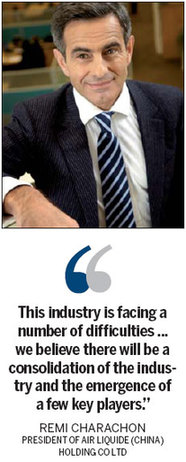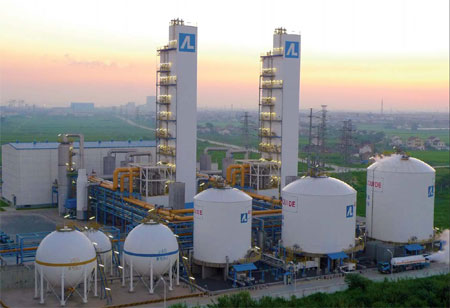Riding the clean energy boom
Updated: 2013-08-02 08:51
By Zhong Nan (China Daily)
|
|||||||||||
|
Air Liquide Group's plant in Zhangjiagang, Jiangsu province. Driven by increasing demand, the company will continue strong investment in China. Provided to China Daily |

French industrial gas producer plans more investments in China to cash in on growth opportunities
Air Liquide Group, the world's largest industrial gas producer by revenue, has launched the second phase of its investment program, called Tengfei II, in China this year. The programs cater to the country's growing demand for oxygen, nitrogen, hydrogen and other gases.
The French company started the first phase of its investment program, Tengfei I, in 2007. The program planned investment of 300 million euros and employment of over 500 new employees every year. Currently, the company has 4,000 employees operating 64 plants in 16 provinces.
Remi Charachon, president of Air Liquide (China) Holding Co Ltd, says Tengfei II will run till 2020 and the French company will continue strong investment and maintain good profitability in China, especially in its west and northwest regions.
The new investment will be spent on expanding Air Liquide's manufacturing facilities, on-site production, technology research, medical gas supply network and Chinese companies' outsourcing production of non-core products.
Industrial gases and related technologies are indispensable to a wide range of industries. They can be applied in healthcare, such as medical oxygen and anesthetic gas, clean energy, high-tech industries such as advanced coal gasification, metallurgy, chemicals, petrochemicals, automotive, food and pharmaceuticals, which are among China's top development priorities.
"China's policies to cut greenhouse gas emissions and improve energy efficiency have offered industrial gas makers great opportunities to maintain a fast growth rate in the world's second-largest economy," says Charachon, who became Air Liquide's China head in 2004 and is also chairman of Singapore-based Asia Industrial Gas Association for China.
In the past two decades, China's inexpensive labor force and resources have assisted the boom in its manufacturing sector, which has had the unfortunate side effects of low profit, heavy pollution and increased energy consumption.
Realizing that these outcomes will slow its economic growth, the Chinese government has pledged that by 2015 it will cut carbon emissions for each unit of GDP by 17 percent from 2010 levels.
China's coal-fired power plants, petrochemicals companies, and steel and cement producers have all scrambled to reduce emissions to prevent having their bank loans stopped or operating licenses revoked by the government.
Charachon says under such circumstances China is seeking high -standard technologies to produce gasoline with lower sulfur, a process that needs hydrogen.
"There are huge projects linked to energy, for instance, transforming coal into gasoline or synthetic natural gas requiring huge quantity of oxygen, and also some other technologies."
The 51-year-old says the emerging trend of outsourcing non-core products to big companies has also brought opportunities to Air Liquide to expand into new regions.
It recently formed a joint venture with Maoming Petrochemical, a subsidiary of Sinopec in Guangdong, to build an air separation unit with a capacity of 3,000 tons of oxygen daily to provide gases for the coal-to-hydrogen project of its existing refinery.
Sun Fuquan, a researcher at the Chinese Academy of Science and Technology for Development in Beijing, says demand for industrial gases will continue to surge over the next decade due to the rapid development of China's healthcare, electronics, photovoltaic, engineering, environmental and urbanization-related industries.
China has become a big buyer of these gases in recent years. It consumed 76 billion yuan ($12.4 billion, 9.3 billion euros) worth of industrial gases last year. The China Industrial Gas Association expects China's demand for industrial gases to reach $15.94 billion by 2016.
"Stable Chinese market growth has further fueled the expansion of foreign industrial gas providers such as France's Air Liquide SA, Germany's Linde AG, the US companies Praxair, Air Products and Chemicals Inc," Sun says. "They have sophisticated technologies to produce high quality gases and set long-term product goals for energy, water and chemical use."
Even though Chinese gas makers outnumber international players in the domestic market, they are still not fully competitive, as they cannot make high-capacity air separation units.
Operating in 80 countries across the world, Air Liquide posted sales of 15.3 billion euros and net profit of 1.6 billion euros in 2012, up from 14.5 billion euros and 1.53 billion euros a year earlier. Charachon says Air Liquide's gas and services sales in China rose 15 percent and the country has become the company's fifth largest global market after the United States, France, Japan and Germany.
To further enhance its presence in China, Air Liquide signed a long-term contract with Fujian Shenyuan New Materials Co Ltd in May to supply industrial gases for its caprolactam production project in Lianjiang Kemen Economic and Development Zone in Fujian province.
It will invest in an industrial gases complex of eight units including an air separation unit of 2,000 tons of oxygen a day, a gasification unit, a purification unit of synthesis gas and an ammonia plant to supply hydrogen, nitrogen and ammonia. They will purify synthesis gas and avoid sulfur emissions, which are responsible for acid rain.
These plants will be operational in 2016 and they will be able to produce 75,000 normal cubic meters per hour of hydrogen and 250,000 tons per year of ammonia.
Charachon says another sector that Air Liquide has been engaged in is China's photovoltaic industry, to which it provides high-purity gases.
"This industry is facing a number of difficulties, such as overcapacity, potential anti-dumping tariffs from the EU, declining prices and low efficiency, we believe that there will be a consolidation of the industry and the emergence of a few key players."
Charachon believes that China's photovoltaic industry will recover step by step.
"Solar is clean energy and renewable, and the Chinese government has been supportive of this industry. From a long-term perspective, this should be an attractive market."
zhongnan@chinadaily.com.cn
(China Daily European Weekly 08/02/2013 page8)
Today's Top News
List of approved GM food clarified
ID checks for express deliveries in Guangdong
Govt to expand elderly care
University asks freshmen to sign suicide disclaimer
Tibet gears up for new climbing season
Media asked to promote Sino-Indian ties
Shots fired at Washington Navy Yard
Minimum growth rate set at 7%
Hot Topics
Lunar probe , China growth forecasts, Emission rules get tougher, China seen through 'colored lens', International board,
Editor's Picks

|

|

|

|

|

|






